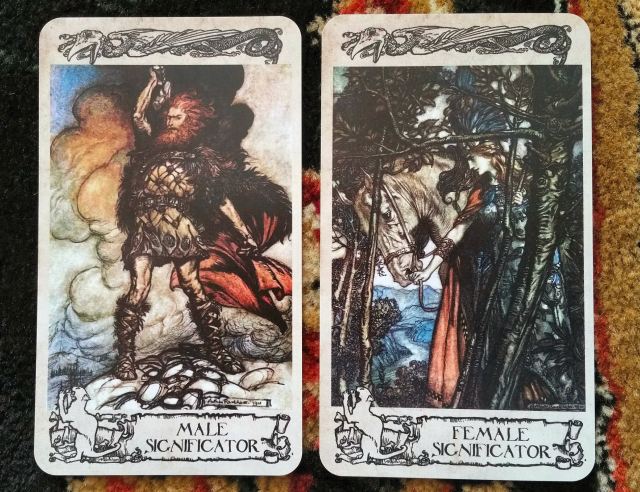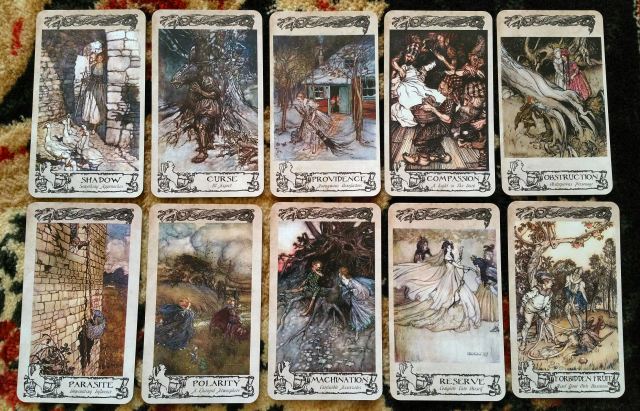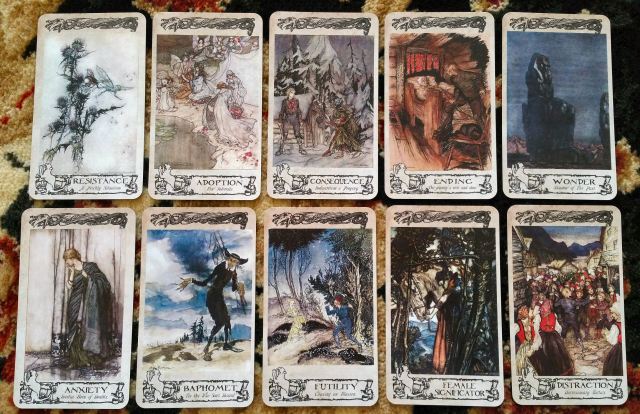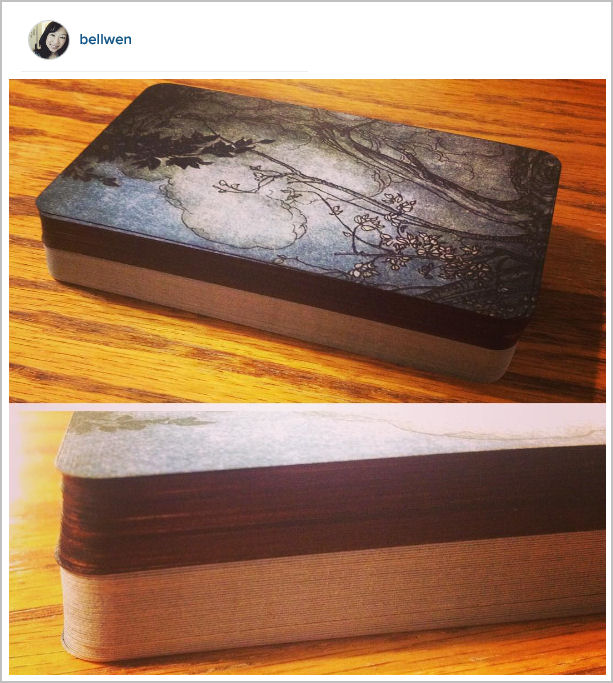The Arthur Rackham Oracle Cards is a self-published deck by Doug Thornsjo through his company, Duck Soup Productions. It’s one of several in his Playroom Oracles series. The oracle deck is conceived by Thornsjo using public domain prints of Arthur Rackham’s illustrations.
Arthur Rackham was an English illustrator with an artistic style that is now considered iconic of the late Victorian and Edwardian eras. Rackham drew with pen and ink (my personal favorite in terms of media for tarot art), watercolor, and–as was common for many Western book illustrators of the time– blended European traditions with Japanese wood block art. You see this same influence in the illustrations of Pamela Colman Smith (who illustrated the RWS deck by A. E. Waite).
Most of Rackham’s art appeared in illustrated fairytale books, from Fairy Tales of the Brothers Grimm (1900, republished 1909), A Midsummer Night’s Dream (1908), and Peer Gynt (1936), which were three books that Thornsjo took most of the imagery for this oracle deck from.
This oracle deck is easily one of my favorites in its execution. I love the keywords, the italicized captions, the layout design for the cards, the selected Rackham illustrations, and the balanced levels of intelligence and creative artistry.
The oracle cards came to me in minimalist packaging, shrink-wrapped by itself, with just those two information cards you see in the first photograph above, no little white booklet, no operating manual of any kind to speak of, no box, no drawstring bag, and I don’t even recall seeing a packing slip. It was all put in a cushioned manila envelope and that was that.
Now, that’s not a terrible thing and it is a superficial gripe on my part, but the bar has been set quite high by other self-published deck creators that I now come to expect an experience when I unbox a self-published deck, especially given the price I’m paying for these decks. Here, no experience. It’s just the cards. That’s it. Right to the point. No frills, no extras, no bonuses, minimal explanation. I confess being a bit dismayed.
Making up for that, however, is the cool fact that I get to choose a custom card back. There are seven options to select from. I went with Option C but it was a tough call. I loved them all. I might have gone with Option F, but to me, that imagery is decidedly “fall,” and I didn’t want this deck to become season-specific. I’m really happy with my Option C. It conveys the mood and tone of this deck quite perfectly.
You see some Lenormand/Kipper and European cartomantic fortune-telling influences here, with the inclusion of two significator cards, “Male Significator” and “Female Significaor.” So far in my dabblings with this deck, I do use the significator cards in the way you’d use them in Lenormand or Kipper readings.
Click on images to view larger size.
The order of cards here are randomized and are not in the same order the deck came in. I’ve been tinkering with the deck (and loving every minute of it). There is a total of 77 cards to work with (two of them the significator cards mentioned above).
Rackham’s iconic Victorian/Edwardian art is perfect for a divination deck and Thornsjo’s crafted keywords and captions pair seamlessly with Rackham’s line drawings. The result is magnificent. I love the ornate decorative bar at the top of the cards, again quite in line with the artistic style of that era. The caption bar at the bottom is very Rackham-esque. The font style for the keywords and captions are so compatible with everything else that I didn’t even notice it. From a graphic design perspective, these cards were evidently done by a master of his craft.
In keeping with the child-like experiences of fairytale art, you have cards that depict bullying, like “Persecution.” “Connectedness” is one of my favorite cards in this deck. “Fortification” is another favorite.
However, another gripe I have is the print quality. If you’ll look at the darker cards above, like “Misled” and “Enlightenment,” the resolution is grainy and should have been sharpened prior to production. The deck description on the Duck Soup website notes that the deck art is taken from scans of Rackham’s book illustrations. Yep. It definitely looks like digital scans, and I wish the image files could have been manipulated just slightly so the scan quality and fuzzy resolution would be less noticeable.
If the artwork was in any other medium, scans would be fine and the slight dullness in the resolution would be acceptable, but with pen and ink illustration specifically, printing has to be of sharp quality. All factors taken in totality, however, this gripe is not significant. I love every other aspect of this deck so intensely that I overlook the fuzziness of the darker-hued cards.
I also dig the different sizes of art, like image size for “Providence” being slightly smaller than the others, as was “Guardianship” earlier. You can see watercolor used in several of the works above, like “Polarity” and “Reserve.” This medium is painstaking to do and requires a Virgo work ethic and attention to detail, which Arthur Rackham has (born September 19). You have to first draw lightly in pencil. To ensure no trace of pencil lines, the next step is lining with waterproof ink, then erasing the pencil. Then you add many layers of watercolor washes to build up the color. Then you have to trace everything over once more with ink, filling in the details. It’s labor-intensive.
The cards cover the whole spectrum of physical and metaphysical themes. There are cards like “Shadow,” “Curse,” and “Craft,” among others, to cover metaphysical motifs. I love “Forbidden Fruit” and its italicized sub-caption, “Mind Your Own Business.”
“Strength” pictured above calls to mind the Strength card in tarot. The “Courage” card reminds me of iconic imagery for The Fool card, and I love the keyword here, “Courage.” There is a Four of Cups vibe to “Renewal” and “Devilment” calls to mind the Seven of Swords, especially with the italicized caption, “Force for Mischief.”

Then cards like “Gossip” and “Temptation” have a Lenormand or fortune-telling-esque quality to them. As I noted earlier about the grainy resolution, see “Awakening,” “Jealousy,” and “Disorientation” above. The picture quality for those cards are fuzzy.
“Amalgamation” is another one of my favorite cards in this deck, featuring beautiful imagery and subtle homage to the tarot Temperance card.
I couldn’t always follow the reasoning for the keyword selection, however, or whether there was a particular thesis arising from this system that Thornsjo has created. The cards “Jealousy” (pictured earlier) and “Covetousness” are so close to each other in energy that I wondered why the deck creator included both. I suppose with “Jealousy” there is an undertone of rivalry or of frenemies, which includes a malicious feeling toward someone else’s success. “Covetousness” isn’t necessarily about wanting what someone else already has, but just wanting, wanting, and wanting more. So I get that there is a subtle distinction, but I am intrigued that both are presented.
“Guile” (pictured above”) and “Quackery” (pictured below) also feel similar in energy to me. Now here you have “Intemperance” (The Temperance card reversed?), which creates an interesting counterpart to the earlier “Amalgamation.”
In “Disquiet,” the crows in the skies are reminiscent of thought disturbances represented by similar birds in the RWS suit of Swords. Intentional or otherwise, these oracle cards are rich with tarot symbolism. Yet paired with the keywords and captions, you can also approach these cards with a Lenormand reading style.
For the “Madrugada” card– let’s not even front– I had to look it up. “Period of time between midnight and sunrise.” Ooh, I like that. The card pictures a beautiful woman sleeping on the ground in a forest, framed with what looks like white oleander, symbolic of tragic love.
I love the fusing of the Red Riding Hood tale with the card “Curiosity.” Note the unique design for the “Intuition” card. Speaking of intuition, we then also have “Afflatus,” the creative-intuition of poets and writers, the act of the muses bestowing brilliance onto the creator. Again, distinctions between cards are often subtle, nuanced.
This oracle deck is going to be highly appealing to writers. There is a writerly quality to how this deck is put together and conceived. “Fecundity” is very The Empress tarot card to me and I love how the imagery for this depiction of The Empress (or “Fecundity”) is shrouded in yin.
The “Destiny” card is another one of my favorites.
“Ending” here could be interpreted in either a Death card sort of way or Four of Swords. “Wonder,” with the caption “Shadow of The Past,” is the present haunting of long ago memories. There is also something nostalgic about this Arthur Rackham Oracle deck. It reminds me of the beautiful hardcover fairytale books I’d flip through as a child.
“Anxiety” is another one of those cards in this deck I really love.
The card “Sangfroid,” about keeping your cool in dicey situations, is paired with imagery of a young man walking in the woods, surrounded by demonic-looking woodland creatures. “Coterie” features adorable card imagery that could be read with a sort of Three of Cups or maybe even Three of Pentacles-ish message.
Some of the cards, like the “Craft” card and a few others depict images in landscape orientation. All of the cards are featured on the Duck Soup website, so be sure to check it out. When I went through the gallery there, I fell in love with the deck immediately. The only thing that held me back was the price, which I presume is higher given the independent publishing of the deck. I don’t usually spend this much on an oracle deck (though I will invest in tarot), but here, I was just so drawn to Thornsjo’s work.
On the surface, Rackham’s art is youthful, innocent, and dream-like, initiating you into a Neptunic world of fantasy. Yet the more you actually work with the deck and the deeper you walk into the images, there is a very grown-up darkness and melancholy coming through. Every reading I did with the oracle deck was told with this haunting, ominous overtone. Somehow, fairytale transforms into horror story at the blink of an eye. The artwork is a mirage. Like the layering of watercolor washes, there are many layers of meaning in each card.
I haven’t decided whether the lack of a companion guidebook or LWB bothers me. I’m leaning toward no, it doesn’t. It might kind of be like requesting an operating manual for a pen. You pull off the cap and start writing with it. Likewise, if you’re a seasoned cartomancer, this deck is pretty easy to pick up and begin reading with. If you’re a Lenormand/Kipper fortune-teller type reader, you’re going to use this deck keyed toward that approach. If you’re a tarot reader, you’re going to see tarot in many if not all of these cards. For the left-brained, the keywords and italicized captions are a great trigger point for your intuition to kick in. For the right-brained, the artwork here is magnificent and you’re going to love how every stylistic aspect of this deck comes together cohesively.
Also, you’ll see in the above photo that I’ve applied a dark walnut stain to the edges of the deck. It’s my new thing, this phase I’m going through with all my newly acquired tarot decks. Sometimes it’s aesthetic–the color palette of that particular deck is just beginning for a complementary toned edging. Other times it’s intuitively purposeful–to help me connect more closely with the deck, as it was here.
I posted the above photo to my Instagram account a while back showing the progress for inking the edges. You’ll see the huge contrast between the original (bottom half of the deck) and the inked edge (top half). For me, the process absolutely adds to the magic of the deck.
I reckon that writers and wordsmiths are going to just fall head over heels in love with The Arthur Rackham Oracle. There is something about how the deck has been put together that will attract the literati. I did find that readings with this oracle deck were rather dark…and stark. There is an elegant gloominess to the deck’s vibe, which I dig but might not be suitable for every kind of reading. Someone going through depression or enduring a darker hour would resonate with this deck and find it to be a loyal companion.
Oddly enough, there has been a synchronistic interest in Arthur Rackham in the cartomancy world this year. The Ring Cycle Tarot by Allegra Printz, published by Schiffer, also rolled out in 2015, like The Arthur Rackham Oracle. Like The Arthur Rackham Oracle, Ring Cycle features the illustrations of Arthur Rackham, though Printz takes an entirely different approach. I haven’t acquired the Ring Cycle Tarot yet, though I want it, especially to compare and contrast with this oracle deck. From what I’ve read, Printz is using adaptations on Rackham’s works, whereas this oracle deck features straight scans of the original illustrations.
The Arthur Rackham Oracle by Duck Soup Productions is a bit of a cerebral deck with strong Mercurial and Plutonian influences. You know that means I love it. There is something a bit Tarot Mucha about it, but shades darker in evocation. It’s got a fantasy vibe like the Shadowscapes Tarot, spun with Dark Romanticism. I am in awe of the imagery and execution, but must confess that I haven’t been able to connect with this oracle deck. I thought the process of inking the edges and working closely with it for a week would help, but it really hasn’t. There is some sort of energetic block between this deck and me, but that does not prevent me from admiring its artistry and pulchritude.
















Beautiful! This is definitely on my wish list 🙂
LikeLike
I love your reference to it being Mercurial and Plutonic…. I will definitely LOVE it… and I have always adored this artist! great review as always… thankyou.
LikeLike
Thank you for this review! The deck is great!))
LikeLike
I look forward to your reviews. These are beautiful cards. I had a comment about the “Jealousy” card. I could not open the image to enlarge it and take a closer look to see how it was depicted.
“Jealousy” however refers to a fear of losing a human connection, such as in the case of a romance or a friendship. What you are describing sounds more like “Envy”.
LikeLike
I agree with Beatrice completely. When I read about the purposeful nuance between “Jealousy” and “Covetousness” I knew this was a quality deck. Jealousy and envy (or covetousness) are not the same at all. Jealousy implies a rival that threatens to take what you have, and deals with people. Envy is wanting something that someone else has… coveting, wanting to posses what you don’t already have.
And I find the correlations with Tarot fascinating.
I will definitely consider this deck! Great review, Benebell 🙂
LikeLike
I have been a huge fan of Rackham’s art for many years, and did not know about this oracle deck until seeing your review today. I have pored over every card (thank you for your beautiful photos), checked out the seller’s website (brilliant), and agree with you about the darkness of the deck. It seems almost severe; however, although I am a bit taken aback by the price, I am heading over to buy this uniquely wonderful set of cards. I just keep THINKING about them! And I love what you did with the edges, Benebell.
LikeLike
I would like to add that I rarely like descriptions at the bottom of cards. In this case, though, the more I look at the cards the more I think that the descriptions are beneficial. Interesting!
LikeLike
Yes, I love cardback option C, too! And the way the card edges are stained. Beautiful. Also, I have to add that the backgrounds and how you choose to display the cards for photography are special as well.
LikeLike
Hey 🙂 Arthur Rackham is an ‘old friend’ since childhood so I was drawn …. what I really want to get across though is how much I’ve loved reading your use of words – excellent and fascinating
LikeLike
They are great! Can someone recommended where I can buy them please? Preferably in the UK.
LikeLike
Love your dark edges. Could you possibly repost the process for this? I cannot find on instagram. Thank you so much
LikeLike